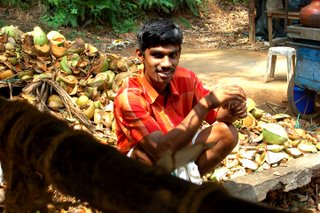The Coconut Sellers

Day 5
5th May 2006, Malapuram
Poverty reduction and raising the standards of India's poor sits high on India's development agenda. In a vast country with a population of over one billion people an estimated 25% are said to be living below the poverty line i.e. on less that USD$1 per day.
Malapuram is a district in Kerala which stretches from the Arabian sea on the west to the Tamil Nadu border on the east. Malapuram struck me as being blessed with an abundance of farming land. It is touted as being the first 100% e-literate district in the country. It is said that at least one member from every household is working overseas, virtually all of whom will be sending remittances back to their families. Life in this district is an odd contrast of affluence and wealth amidst a back drop of poverty.
Whilst driving along the road in the hot mid-day sun we chanced upon a wide corner on the road distinctly marked by three coconut stands. We were thirsty, it was hot, so we stopped.
We met Valmana Prasad, a man in his early forties with a healthy glow, seven children and the proud owner of the three coconut stands. In two swift and deft chops of a dangerous looking machete he managed to pierce the top of a coconut for us to drink. The water from the green coconut was remarkably sweet. When the coconut water was finished Valmana took the coconut back and with unbelievable ease split the coconut in two and and offered us the tender inner-flesh to savour. Needless to say the flesh which was soft and slippery was much to my palate's delight.

Valmana buys 100 coconuts per day for each of the three stands (he runs one and his oldest sons, Prasad and Kuttypuram run the other two). Each coconut is sold for ten rupees, having no doubt bought them in the market, for say half that price. Whilst Kuttypuram (aged 23) bears the dark scars on the inside of his wrists and ankles from years of climbing coconut trees (he told me he could shimmy up a tall tree in four minutes), the family chooses to buy the coconuts from others. This was a carefully worked out business plan, having weighed the time and labour inputs required against the profits generated. Careful calculations lead them to prefer to source the coconuts rather than grow them or for that matter any other vegetables or fruits. Valmana's father had farmed rice, but like many in Kerala, he decided to move from a low yielding and labour intensive food crop to selling a more profitable cash crop - coconut.

Together they seemed to do well in the coconut business. All were fit and well. Clearly each generation was moving with the times. Like his father, who had decided to find a more rewarding alternative livelihood, Prasad (aged 16) too, was aiming to do a course in computers and was working to maintain a good academic record in addition to helping out with the family business. One of Valmana's three daughters was married, but she is also pursuing a bachelor's degree in arts (BA). Valmana Prasad was a proud man. He had his sons at his side and he was more than happy to explain his craft and trade to us.
Apart from the eldest, none of the family was e-literate, but there were certain lofty and attainable aspirations to do well. Selling around 300 coconuts a day, seven days a week at a busy corner in the road certainly made for a modest income and what appeared to a casual traveller like me to be a happy life.
Pete
